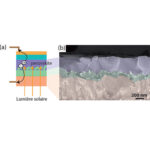More efficient peroskite solar cells by inserting metallic nanoparticles

In order to offset the exit from fossil fuels, the development of renewable energies is a crucial issue – coupled of course with a reduction in our energy consumption. In the field of photovoltaic solar energy, the new materials of the perovskite family show encouraging performances. They can be deposited by relatively simpler and more economical processes than the silicon currently used. Many ongoing studies aim to control their large-scale deposition and their stability (aging, temperature) without reducing their light absorption and charge generation properties. Nanostructures and Optics team from the INSP collaborated with the Institut de Recherche de Chimie Paris to analyze how the absorption of light by a perovskite cell was modified by the addition of metallic nanoparticles.
Caption
(a) Diagram of a perovskite cell. The light is absorbed by the perovskite layer, giving rise to charges evacuated by two electrodes at the top and bottom. (b) Scanning electron microscopy image of the perovskite cell (after the perovskite layer deposition stage: the upper layers are not yet deposited).
Reference
“How do gold nanoparticles boost the performance of perovskite solar cells?”
Daming Zheng, Catherine Schwob, Yoann Prado, Zakarya Ouzit, Laurent Coolen et Thierry Pauporté
Nano Energy, 94, 106934 (2022)
laurent.coolen(at)insp.jussieu.fr
